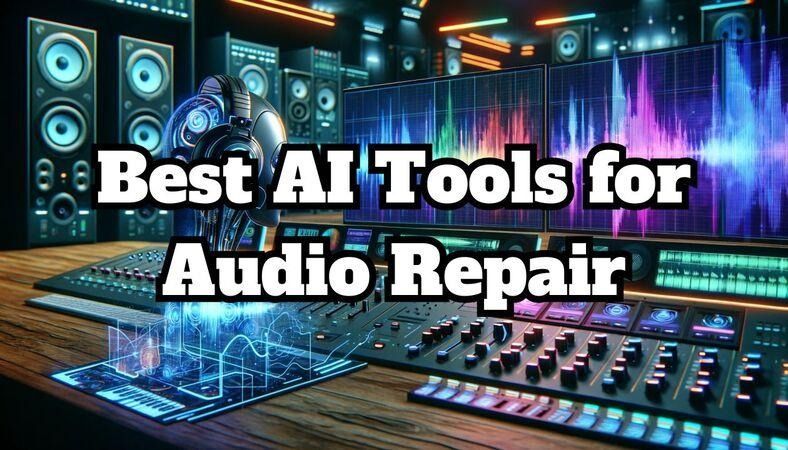

Let’s learn more about this topic below with Bottle Flip. In the ever-evolving landscape of artificial intelligence, audio repair and noise reduction tools have become indispensable for students and creators alike. These AI-powered solutions offer remarkable capabilities to enhance audio quality, remove unwanted background noise, and restore damaged recordings. As we delve into the world of AI audio tools, we’ll explore their features, benefits, and applications across various fields.
AI-powered audio repair and noise reduction tools have revolutionized the way we approach sound editing and enhancement. These sophisticated algorithms leverage machine learning and deep neural networks to analyze audio waveforms, identify imperfections, and apply intelligent corrections. By understanding the nuances of different audio sources and noise types, these AI tools can effectively separate desired sounds from unwanted interference, resulting in cleaner, more professional-quality audio.
The applications of AI audio repair tools extend far beyond simple noise reduction. They can address a wide range of audio issues, including removing clicks, pops, and hum, restoring old recordings, enhancing speech clarity, and even reconstructing missing audio segments. For students and creators working with audio content, these tools have become invaluable assets in their creative arsenal.
One of the key advantages of AI-powered audio repair tools is their ability to adapt and improve over time. As these systems are exposed to more diverse audio samples and user feedback, they continually refine their algorithms, resulting in more accurate and effective noise reduction and audio enhancement. This iterative learning process ensures that the tools remain at the cutting edge of audio technology, providing users with increasingly sophisticated capabilities.
When evaluating AI tools for audio repair and noise reduction, it’s essential to consider the key features that set them apart. These features not only determine the tool’s effectiveness but also its suitability for different user needs and skill levels. Let’s explore some of the most important features to look for in AI audio repair tools:
At the core of any AI audio repair tool is its noise reduction capability. Advanced algorithms analyze the audio spectrum to identify and isolate unwanted noise, whether it’s background chatter, environmental sounds, or electrical interference. The best tools can differentiate between various types of noise and apply targeted reduction techniques without compromising the quality of the desired audio. This intelligent approach ensures that important audio elements are preserved while unwanted noise is effectively eliminated.
Some AI tools take this a step further by offering adaptive noise reduction, which dynamically adjusts its parameters based on the changing characteristics of the audio. This is particularly useful for recordings with varying noise levels or types throughout the duration of the audio. The ability to handle complex noise profiles sets these AI tools apart from traditional noise reduction methods.
Beyond noise reduction, AI audio repair tools often include sophisticated restoration and enhancement features. These can range from repairing clipped audio and removing clicks and pops to more advanced functions like spectral repair and harmonic enhancement. Some tools even offer the ability to reconstruct missing audio segments based on the surrounding context, a feat that was previously impossible with traditional audio editing techniques.
For students and creators working with archival material or damaged recordings, these restoration features can be game-changing. They allow for the revival of old audio that might otherwise be unusable, opening up new possibilities for research, preservation, and creative projects. The Bottle Flip technique, while not directly related to audio repair, exemplifies the kind of innovative approach that these AI tools bring to the table, transforming seemingly impossible tasks into achievable goals.
One of the most valuable features of modern AI audio repair tools is real-time processing and preview capabilities. This allows users to hear the effects of their adjustments immediately, streamlining the editing process and enabling more precise fine-tuning. Real-time processing is particularly beneficial for live applications, such as podcasting or streaming, where immediate noise reduction and audio enhancement are crucial.
Many tools also offer split-screen or A/B comparison features, allowing users to quickly assess the before and after effects of their audio repairs. This immediate feedback loop not only saves time but also helps users develop a better understanding of how different settings and parameters affect the audio quality.
The versatility of AI audio repair and noise reduction tools makes them invaluable for a wide range of applications. For students and creators, these tools open up new possibilities and enhance existing workflows across various disciplines and creative endeavors. Let’s explore some of the key applications where AI audio tools can make a significant impact:
In academic settings, AI audio repair tools have numerous applications that can greatly benefit students and researchers. For those conducting interviews or field recordings as part of their research, these tools can salvage recordings made in less-than-ideal conditions, ensuring that valuable data is not lost due to poor audio quality. This is particularly crucial in disciplines such as anthropology, sociology, and oral history, where primary source recordings are often irreplaceable.
Students working on multimedia projects or presentations can use these tools to enhance the audio quality of their work, resulting in more professional and engaging content. For language learners, AI audio enhancement can improve the clarity of pronunciation samples and listening exercises, making it easier to discern subtle linguistic nuances.
In the realm of scientific research, AI audio repair tools can be invaluable for analyzing acoustic data. Whether it’s studying animal vocalizations in noisy environments or examining subtle sound patterns in physical phenomena, these tools can help isolate and clarify the relevant audio information. The ability to remove extraneous noise and enhance specific frequency ranges can reveal insights that might otherwise be obscured.
For content creators, AI audio repair and noise reduction tools have become essential components of the production process. Podcasters, for instance, can use these tools to clean up recordings made in less-than-ideal acoustic environments, removing background noise and enhancing vocal clarity. This is particularly useful for interview-style podcasts or those recorded on location, where controlling the recording environment is challenging.
Video producers and filmmakers can leverage AI audio tools to improve the quality of on-location dialogue recordings, reducing the need for extensive ADR (Automated Dialogue Replacement) sessions. These tools can also be used to enhance the overall sound design of a project, cleaning up ambient recordings and creating more immersive audio experiences.
Musicians and audio engineers find AI audio repair tools invaluable in the recording and mixing process. These tools can help salvage otherwise unusable takes by removing unwanted artifacts or reducing bleed between instruments. In the realm of music restoration, AI-powered tools are pushing the boundaries of what’s possible, allowing for the separation of individual instruments from mono recordings and the enhancement of vintage recordings.
For voiceover artists and audiobook narrators, AI audio repair tools offer a way to achieve studio-quality recordings even when working from home studios or less-than-ideal acoustic spaces. By reducing room reflections and background noise, these tools help ensure that the focus remains on the narrator’s voice, resulting in a more professional and engaging listening experience.
With a plethora of AI audio repair and noise reduction tools available in the market, choosing the right one can be a daunting task. The best tool for you will depend on your specific needs, skill level, and budget. Here are some factors to consider when selecting an AI audio repair tool:
Ease of Use: For students and creators who may not have extensive audio engineering experience, an intuitive user interface is crucial. Look for tools that offer clear, visual representations of audio waveforms and easy-to-understand controls. Some tools provide presets for common audio issues, which can be a great starting point for beginners.
Processing Power: Consider the computational requirements of the AI tool and ensure that your hardware can handle it. While some tools are designed to run efficiently on standard computers, others may require more powerful systems, especially for real-time processing of high-resolution audio.
Integration with Existing Workflows: If you’re already using specific digital audio workstations (DAWs) or video editing software, look for AI audio repair tools that integrate seamlessly with your existing setup. Many tools offer plugin versions that can be used directly within your preferred software.
Customization and Control: While AI-powered tools can produce impressive results automatically, having the ability to fine-tune parameters is important for achieving precise results. Look for tools that offer a good balance between automated processing and manual control.